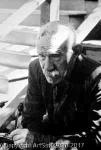Henry Darger
Henry Darger
Place: Chicago
Born: 1892
Death: 1973
Biography:
Henry Joseph Darger Jr. was a reclusive American writer and artist who worked as a hospital custodian in Chicago, Illinois. He has become famous for his posthumously discovered 15,145-page, single-spaced fantasy manuscript called The Story of the Vivian Girls, in What Is Known as the Realms of the Unreal, of the Glandeco-Angelinian War Storm, Caused by the Child Slave Rebellion, along with several hundred drawings and watercolor paintings illustrating the story.
The visual subject matter of his work ranges from idyllic scenes in Edwardian interiors and tranquil flowered landscapes populated by children and fantastic creatures, to scenes of horrific terror and carnage depicting young children being tortured and massacred. Much of his artwork is mixed media with collage elements. Darger's artwork has become one of the most celebrated examples of outsider art.
Darger was born in Chicago, Illinois, to Henry Darger Sr. and Rosa Fullman. Cook County records show he was born at home, located at 350 W. 24th Street. When he was four years old, his mother died of puerperal fever after giving birth to a daughter, who was given up for adoption; Darger never knew his sister. One of his biographers, the art historian and psychologist John M. MacGregor, discovered that Rosa had two children before Henry, but did not discover their whereabouts.
By Darger's own account, his father was kind and reassuring to him and they lived together until 1900. In that year, the crippled and impoverished Darger Sr. was taken to St. Augustine's Home for the Aged. Because of his apparent intellect, the young Darger was initially enrolled in public school at the third grade level; after his father became crippled, Darger was moved to the Mission of Our Lady of Mercy, a Catholic orphanage. Darger Sr. died in 1905, and his son was institutionalized in the Illinois Asylum for Feeble-Minded Children in Lincoln, Illinois, also called the Lincoln State School (today the Lincoln Developmental Center), with the diagnosis, according to Stephen Prokopoff, that "little Henry's heart is not in the right place". According to John MacGregor, the diagnosis was actually "self-abuse", a euphemism for masturbation.
Darger himself felt that much of his problem was being able to see through adult lies and becoming a "smart-aleck" as a result, which often led to his being disciplined by teachers and ganged up on by classmates. He also went through a lengthy phase of feeling compelled to make strange noises (perhaps as a result of Tourette syndrome) which irritated others. The Lincoln asylum's practices included forced labor and severe punishments, which Darger would later seemingly incorporate into his writing. Darger later said that, to be fair, there were also good times at the asylum, he enjoyed some of the work, and he had friends as well as enemies. While he was there, Darger received word that his father had died. A series of attempted escapes ended successfully in 1908. The 16-year-old returned to Chicago and, with the help of his godmother, found menial employment in a Catholic hospital and in this fashion continued to support himself until his retirement in 1963.
Except for a brief stint in the U.S. Army during World War I, his life took on a pattern that seems to have varied little: he attended Mass daily, frequently returning for as many as five services; he collected and saved a bewildering array of trash from the streets; his dress was shabby, although he attempted to keep his clothes clean and mended; and he was largely solitary. His one close friend, William Schloeder, was of like mind on the subject of protecting abused and neglected children, and the pair proposed founding a "Children's Protective Society" that would put such children up for adoption to loving families. Schloeder left Chicago sometime in the mid-1930s, but he and Darger stayed in touch through letters until Schloeder's death in 1959. Darger biographer Jim Elledge speculates that Darger and Schloeder may have had a romantic relationship while Schloeder lived in Chicago.
In 1930, Darger settled into a second-floor room on Chicago's North Side at 851 W. Webster Avenue in the Lincoln Park section of the city, near the DePaul University campus. It was in this room for the next 43 years that Darger would imagine and write his massive tomes (in addition to a 10-year daily weather journal and assorted diaries) until his death in April 1973 in St. Augustine's Home for the Aged, the same institution in which his father had died. In the last entry in his diary, he wrote: "January 1, 1971. I had a very poor nothing like Christmas. Never had a good Christmas all my life, nor a good new year, and now... I am very bitter but fortunately not revengeful, though I feel should be how I am..."
Darger is buried in All Saints Cemetery in Des Plaines, Illinois, in a plot called "The Old People of the Little Sisters of the Poor Plot". His headstone is inscribed "Artist" and "Protector of Children".
More...
Wikipedia link: Click Here

